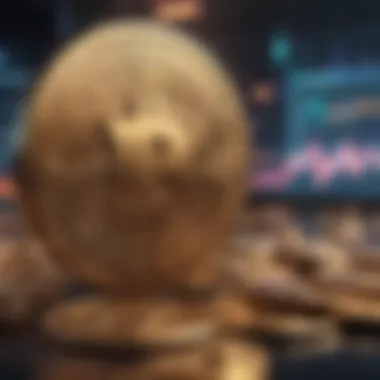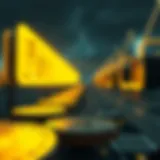Identifying Prime NFT Opportunities for Investors


Intro
The world of non-fungible tokens (NFTs) is a vibrant and rapidly evolving frontier, filled with opportunities for those who know how to navigate it. With a flood of digital art, collectibles, and various unique assets crowding the marketplace, investors are tasked with sifting through a multitude of options to identify those that truly hold value. In an environment where hype can often overshadow substance, understanding key concepts of cryptocurrency becomes crucial for making informed decisions.
This guide aims to sharpen your ability to recognize prime NFT opportunities by diving into the mechanics of the underlying technology, assessing market trends, and analyzing the factors that contribute to the desirability of different NFTs. From blockchain basics to investment strategies, we’ll cover the essential components that can shape your journey into the NFT space.
Understanding NFTs
Grasping the concept of non-fungible tokens (NFTs) is fundamental for anyone hoping to navigate today’s digital investment landscape. NFTs, a unique breed of digital assets underpinned by blockchain technology, have burst onto the scene like a breath of fresh air. Unlike their traditional counterparts, these tokens hold distinct characteristics that not only define ownership but also elevate digital items to a tier where scarcity and uniqueness collide. In this section, we shall unpack the layers surrounding NFTs, exploring their very essence, and contrasting them with traditional assets to sharpen your investment strategies. Understanding NFTs goes hand in hand with recognizing the immense potential they present, as well as the inherent challenges.
Definition and Characteristics of NFTs
So, what exactly are NFTs? At their core, non-fungible tokens represent ownership of a specific item or piece of content verified through blockchain technology. Each NFT holds a unique identifier, setting it apart from other tokens. This means that, unlike a dollar bill, which can be exchanged for any other dollar bill, an NFT cannot be replaced with another NFT of equivalent value.
Some standout characteristics of NFTs include:
- Uniqueness: Each NFT has exclusive properties that distinguish it, providing owners with proof that their digital item is irreplaceable and authentic.
- Indivisibility: Unlike cryptocurrencies like Bitcoin, NFTs cannot be divided into smaller units. This indivisibility adds to the item’s allure.
- Interoperability: NFTs can be programmed to function within multiple ecosystems, making them versatile assets across various platforms.
- Provenance: The blockchain ledger records the history of ownership, helping to establish authenticity and often raising the value of the NFT as its provenance becomes apparent.
Understanding these traits leads one to appreciate why NFTs have become a popular investment vehicle among collectors, artists, and gamers alike.
How NFTs Differ from Traditional Assets
The contrast between NFTs and traditional assets is like comparing apples to oranges. Traditional assets, think real estate, stocks, or even your grandma's precious coin collection, can be easily traded or exchanged for others of equal value. However, with NFTs, it’s a whole different ballgame.
Consider the following points of divergence:
- Settlement: In the realm of traditional assets, transactions can involve significant intermediaries such as brokers or banks while NFTs operate on a direct peer-to-peer basis, thanks to blockchain.
- Valuation: Traditional items are often valued based on market consensus, historical data, and potential for future profit. On the flip side, NFTs can have vastly varying prices depending on culture, scarcity, and community sentiment.
- Liquidity: Selling traditional assets might require time and careful negotiation. NFTs, particularly popular ones, can be bought or sold within moments, especially on platforms like OpenSea or Rarible.
- Accessibility: Any individual, regardless of background, can create or trade NFTs. This democratizes the art and collectible markets, unlike traditional asset markets which may be gatekept by wealth and resources.
"While traditional assets are often bound by rigid systems of valuation and exchange, NFTs fling open the doors of opportunity, creating a vivid marketplace like we've never seen before."
Overall, understanding what NFTs are, their distinctive characteristics, and how they diverge from traditional assets, equips investors and enthusiasts alike with the necessary insight to navigate and seize opportunities in this burgeoning sector.
The NFT Market Landscape
The landscape of the NFT market is continually shifting, and understanding its nuances is crucial for anyone looking to make wise investments. It’s a bit like venturing into uncharted waters; you wouldn’t want to sail into a storm without a map. The NFT marketplace is a melting pot of creativity and technology, merging the best of both worlds and offering a vast array of opportunities.
In this section, we’ll cover the importance of recognizing the shifts in the marketplace, what trends are bubbling to the surface, and which categories are garnering the most interest and investment. Keeping a pulse on these aspects can be the difference between hitting the jackpot or finding oneself with a digital asset that’s lost its spark.
Current Trends in the NFT Market
Current trends paint a vibrant picture of where the NFT market stands today. One notable change has been the shift towards community-driven initiatives. Back in the earlier days, many people were primarily enamored with artwork and collectables. Now, the focus has expanded. Projects like Axie Infinity and Decentraland show how utility—the value derived from owning an asset beyond mere ownership—has become a major driver in the space.
Moreover, collaborations between established brands and digital artists continue to rise, causing ripples in how NFTs are perceived and valued. Exclusive drops and partnerships can stir excitement and engagement, setting the stage for FOMO (fear of missing out), which often drives prices up rapidly.
- Community Building: Many NFT creators are engaging with the audience, fostering a vibrant community that adds value to their projects.
- Sustainability: There’s a growing consciousness surrounding the environmental impact of NFTs, leading to innovations in greener blockchain technologies.
Emerging NFT Categories
With the evolution of the NFT market, several categories have emerged, each with its characteristics that appeal to different kinds of investors. Let’s delve into these categories.
Art
Art NFTs have taken the spotlight, showcasing works from established and emerging artists alike. This trend isn’t just about critiquing the artistic merit, rather it dives deep into what art represents in a digital world. One key characteristic of art NFTs is their ability to self-validate provenance in a way traditional art could only dream of.
Artists can sell pieces directly to collectors without gallery middlemen, simplifying transactions. A unique feature of this category is that it allows artists to set royalties for future sales. This means that as a piece grows in value, the artist benefits from each transaction, creating a win-win scenario. However, the market is subject to speculation, leading to swings in value that could leave both artists and buyers in precarious positions.
Gaming


Gaming NFTs have reinvigorated the concept of ownership in digital spaces. Players can own, sell, and trade in-game items that are secured by blockchain technology. A highly appealing characteristic of gaming NFTs is their intersection with play-to-earn models, offering real financial rewards for users who invest time in the game.
The distinct unique feature here is that ownership of digital assets can lead to new revenue streams and can transform gameplay. However, the downside is that regulatory scrutiny is increasing in gaming, and the gaming community is rightfully wary of the encroachment of overly monetized models into their beloved experience.
Virtual Real Estate
Virtual real estate is another fascinating category that's cropping up, allowing individuals to buy, sell, or develop plots of digital land. The concept is akin to owning a piece of the web, where users can build experiences or create value. A key characteristic of virtual real estate is its potential for passive income; owners can lease plots or monetize through different avenues.
This category’s unique feature is the emotional connection users feel toward building and creating spaces in virtual environments, which could lead to tremendous appreciation in value. However, potential owners should consider the inherent volatility of virtual property and the ongoing discussion about the longevity of such platforms.
Music
Music NFTs present an avenue for artists to monetize their creations directly. With traditional methods slowly falling by the wayside, many musicians look to NFTs as a way to regain control over their works. A notable characteristic is the growing trend of tokenizing entire albums or tracks, allowing fans to invest directly in the art they love.
A specific unique feature here is how music NFTs can embed special benefits, like access to exclusive concerts or meet-and-greet sessions with the artists. However, as with other categories, a concern arises regarding the sustainability of this model, especially in a market filled with similar offerings competing for attention.
Understanding these emerging categories helps investors pinpoint areas with growth potential and to strategize accordingly for a diversified investment portfolio.
Factors Making NFTs Worthy Investments
In the intricate world of non-fungible tokens, the investment landscape can resemble a wild frontier, bustling with unique opportunities yet fraught with uncertainty. Understanding the factors that make NFTs worthy investments is crucial for anyone looking to navigate this evolving market. Several elements hold significant weight when determining the potential return on NFTs, including rarity, creator reputation, and utility.
Rarity and Scarcity
Rarity and scarcity stand at the forefront of what makes certain NFTs appealing. Think of it like a collection of rare coins or stamps—those who manage to snag a limited edition stand with a leg up at resale time. In the NFT world, when an artist releases a new piece and only a handful of copies exist, that inherent scarcity feeds into its demand.
Possible buyers are often drawn to the idea of owning something that few others can claim. This leads to an interesting cycle: as more people clamor for these rare pieces, the value tends to soar. However, it’s not merely about the quantity available; the context matters too. An NFT connecting to a trending cultural moment or tied to a remarkably talented creator can further elevate its desirability.
"In the realm of collecting, scarcity creates desire. When fewer pieces are available, their allure intensifies."
Creator Reputation and Brand
The person or entity behind an NFT can dramatically affect its market value. Well-known artists, musicians, or brands can lend credibility to their creations that new or unknown creators may lack. This human element plays a pivotal role; for instance, a digital artwork by an artist with a substantial following can demand a higher price than the same piece by someone virtually unknown.
Investors should carefully analyze the creator's track record, engagement with their community, and overall influence. Successful creators often have loyal followers who may be not just consumers, but active participants in promoting new releases.
Recognition breeds trust; when there’s trust, the odds favor rising values. It’s much like choosing stocks—investing in reputable companies is generally safer than betting on the new startup that just popped up.
Utility and Functionality
Another angle to consider is the utility and functionality of NFTs. Not all tokens serve merely as digital decor. Some come with real-world benefits or functionalities that can enhance their worth.
For instance, certain NFTs may grant access to exclusive events, parties or other experiences, while some gaming NFTs allow players to use them within a game. This practical application enhances the intrinsic value of the token, making it more than just a collectible.
The ability to leverage an NFT for something tangible or experiential can set it apart in a crowded marketplace. Consequently, the perspective on NFTs shifts from viewing them as mere digital artifacts to assets that can provide additional benefits or utility.
In essence, recognizing these factors—rarity, creator reputation, and utility—will equip investors with the tools to make astute decisions in the NFT space. By considering these aspects, one can separate the wheat from the chaff and hone in on prime opportunities.
Top NFT Projects to Consider
When diving into the realm of NFTs, it's vital to identify which projects stand out amongst the myriad of options available today. The key lies not just in evaluating aesthetics or surface-level appeal, but rather comprehending the underlying elements that drive the success of these projects. Understanding these prime NFT projects can aid potential investors in making educated decisions. Not only do successful projects have a certain pedigree or reputation, but they also contribute significantly to overall trends in the market. By recognizing top-tier NFT projects, investors can ensure they allocate their resources wisely, balancing potential risk with substantial return on investment.
Established Art-Based Projects
In the NFT space, art-based projects have been at the forefront of innovation and interest. They often serve as a benchmark for valuing NFTs, especially those that carry significant cultural weight. Overall, two projects tend to stand out in this category: CryptoPunks and Bored Ape Yacht Club. Each of these encompasses unique qualities that have catapulted them into the spotlight and solidified their place in the NFT world.
CryptoPunks
CryptoPunks are arguably some of the earliest and most recognizable NFT projects in existence. These unique 24x24 pixel art characters have set a gold standard for what defines digital scarcity. The key characteristic of CryptoPunks is their limited supply; only 10,000 punks were created. This rarity contributes to their allure, as collectors are always on the hunt for unique ownership.


What distinguishes CryptoPunks from others is how they represent an early adoption of blockchain technology for artistic expression. The advantages are clear: Punk owners often see substantial appreciation in value, making them a sought-after asset in the NFT world. However, the disadvantages may include high entry costs, as many mounted over the initial asking prices, thus making it inaccessible for some potential investors.
Bored Ape Yacht Club
Bored Ape Yacht Club, often shortened to BAYC, has gained dizzying notoriety. What sets this project apart from others in the NFT space is the sense of community that accompanies ownership. Each Bored Ape serves as a membership pass to an exclusive social club, offering various perks, such as special events and member-only activities. The project stands out due to its engaging branding and marketing, often seen as a status symbol among NFT holders.
The biggest draw for investors is the unique characteristics and artistic value each ape possesses. In this club, rarity extends beyond ownership; certain features, attire, and accessories elevate some Apes above the rest. However, like any investment, the speculative nature of NFTs means that market fluctuations can lead to declines in value, reminding buyers they must tread carefully in this fast-paced environment.
Innovative Gaming NFTs
In recent years, the gaming sector has surged ahead in the NFT marketplace, integrating digital assets in exciting ways. Projects like Axie Infinity and Decentraland highlight the innovation taking place within the gaming community, creating opportunities for users to earn while they play.
Axie Infinity
Axie Infinity is a prominent name in the gaming NFT world, known for its play-to-earn model where players can make money while enjoying gameplay. One cannot overstate the revolutionary aspect of this; players can breed, battle, and trade creatures known as Axies, transforming passive play into an active revenue stream. Its key characteristic revolves around building a community-driven economy where NFTs are vital.
The unique feature of Axie Infinity lies in its combination of gaming and blockchain technology. Players effectively become stakeholders in the game's economy, enabling them to trade their Axies in a lively marketplace. However, the disadvantages stem from the high entry price for purchasing Axies, which may deter newcomers looking to enter without significant upfront investment.
Decentraland
Decentraland provides a distinctly different approach to NFTs by allowing users to purchase, develop, and trade virtual real estate within a fully immersive 3D world. This project epitomizes how NFTs can transcend traditional boundaries; it’s not just about ownership but also about creativity in a decentralized space. As users build and monetize their parcels, the potential grows for both entertainment and investment.
One of Decentraland’s standout features is the vibrant social interactions it encourages. Users can host events, operate businesses, and engage with other community members. Yet, with all that potential, there's an inherent risk; as technology is ever-evolving, projects like Decentraland may face challenges in gaining sustained interest over the long term.
Noteworthy Music NFTs
As the NFT market continues to expand, music is slowly carving out its niche. Music NFTs give artists an innovative way to sell their work while maintaining ownership rights. Unlike traditional distribution methods where artists often see a mere fraction of revenue, music NFTs open the doors for fairer compensation.
Known artists are beginning to explore this realm, bringing their fan bases along for the ride. The result is a burgeoning sector that not only enriches the artist's portfolio but also offers a new experience for music lovers. As the industry evolves, those invested in music-related NFTs stand to gain an interesting intersection of culture and finance.
Evaluating NFT Value
When it comes to navigating the complex world of NFTs, assessing their value is crucial. As the digital art landscape continues to evolve, the determination of worth becomes a multifaceted challenge that requires attention to several key elements. Investors and collectors alike need a robust framework to discern valuable NFTs from the merely popular or hyped ones. Within this context of fluctuating market dynamics, evaluating NFT value goes beyond mere pricing; it unfolds the layers of significance attached to an asset’s work and its creator.
This section will focus on three primary pillars: the use of market analytics tools, understanding sales history and trends, and gauging community sentiment and engagement. By unpacking these topics, readers will be better equipped to navigate their NFT investments, ensuring they make decisions that are not just impulse buys but well-reasoned investments that align with their objectives.
Market Analytics Tools
To effectively gauge the value of NFTs, one must embrace a suite of market analytics tools. These specialized platforms provide data-driven insights that help potential buyers assess more than just the aesthetic appeal of an NFT.
- Dune Analytics: This platform allows users to create custom dashboards that pull data from the blockchain, illuminating various trends and behaviors in the NFT space. Investors can track metrics like sales volume and price fluctuations over time.
- OpenSea Stats: As one of the largest NFT marketplaces, OpenSea provides a plethora of data on trending collections, sales histories, and current listings, offering a transparent view of what's moving in the market.
Access to this information can simplify the often murky waters of NFT valuation, empowering investors to base decisions on quantifiable data. A comprehensive understanding of what is hot today can lead to uncovering tomorrow's gold mines.
Sales History and Trends
Understanding the sales history and trends of specific NFTs is akin to reading a stock chart but in a vibrant digital realm. Analyzing past sales helps frame what kinds of price tags these assets can command in fluctuating markets. Whenever exploring the sale history of a particular NFT, consider the following:
- Price Variance: Look at how the price has changed over time. Is it routinely jacked up by hype, or does it hold value after initial sales?
- Volume of Sales: A high number of transactions may suggest desirability and community trust, which are vital indicators for potential growth.
- Similar Assets: Comparing with NFTs in the same category or by the same creator can shed light on relative worth.
By embracing a historical perspective, investors can make better judgments. They’re not just buying art; they’re buying potential.
Community Sentiment and Engagement
Finally, the heartbeat of the NFT space lies within its community. Community sentiment and engagement are often underestimated when evaluating NFT value, yet they should not be overlooked. The fervor and commitment of a community can significantly affect an NFT's worth.
Indicators of strength include:
- Social Media Presence: Platforms like Twitter and Discord are vital conduits for community discussion around upcoming drops, trends, and the latest news.
- Artist and Brand Interaction: An NFT creator that engages actively with their followers can cultivate loyalty and enthusiasm—essential ingredients for potential value appreciation.
- Community-built Ecosystems: Projects that foster a robust ecosystem, like Decentraland, hint at long-term engagement, which can stabilize and elevate value.


"Evaluate not just the NFT itself, but the energy surrounding it; that is where the real potential lies."
Risks Associated with NFT Investments
Investing in non-fungible tokens (NFTs) can seem like a lucrative venture. Yet, it is essential to tread carefully, as various risks lurk beneath the surface. A clear understanding of these risks is pivotal in making informed decisions. Recognizing the pitfalls can help savvy investors navigate the choppy waters, allowing them to strategically position themselves in this ever-changing landscape.
Market Volatility
NFTs aren’t immune to the drastic swings often associated with the crypto market. Prices can fluctuate wildly, sometimes in a matter of hours. One minute an NFT is fetching millions; the next, it might barely make a fraction of that amount. This volatility is driven by factors, including market sentiment, speculation, and overall trends in the digital art and collectibles space.
Investors need to keep an eye on broader market dynamics. Drawing parallels with traditional assets may prove futile, as the NFT market can react unpredictably due to social media buzz, celebrity endorsements, or even market manipulation – perhaps from a single influential participant. So, if you decide to dip your toes into this realm, prepare for a rollercoaster ride.
Potential for Fraud and Scams
The promise of digital ownership can sometimes attract unscrupulous characters. As NFTs gain popularity, so too do the schemes that aim to exploit that popularity. Fraudulent projects, fake collections, and phishing sites are just a few of the dangers out there. It’s crucial to conduct detailed due diligence before committing any funds. Having the right precautions in place can mean the difference between a successful investment and a regrettable loss.
A standard practice is to verify the authenticity of an NFT, ensuring it's coming from a legitimate creator or platform. Relying solely on hype can lead you down a rabbit hole of disappointment. Protect yourself by cross-checking URLs, engaging with community feedback, and analyzing sellers’ histories.
Legal and Regulatory Concerns
The regulatory environment surrounding NFTs is still developing. While some jurisdictions have clear guidelines about digital assets, others are lagging behind or even imposing restrictions. The legal landscape can change swiftly, potentially impacting how NFTs can be bought, sold, or even owned.
Consider that copyright issues may arise if an NFT contains elements that infringe upon intellectual property rights. Such complications can result in legal disputes that might not only tarnish the value of your investment but also lead to financial penalties or worse. Therefore, staying abreast of local regulations, understanding copyright laws, and recognizing how they apply to digital assets is essential for any potential investor.
"The rapidly evolving nature of the NFT market calls for vigilance and prudence. Understanding the risks isn't just practical; it's necessary for any serious investor."
As you embark on your NFT investment journey, remember that knowledge is power. By understanding market volatility, being aware of fraud risks, and staying informed about legal concerns, you can enhance your chances of making wise investment decisions in this unpredictable landscape.
The Future of NFTs
The conversation surrounding the future of NFTs is crucial in understanding how the landscape of digital assets will evolve. This section evaluates the ongoing trends and technological innovations that promise to reshape not only how we think of NFTs but also their functionality and their role in a rapidly digitizing world. As investors, traders, developers, and analysts, grasping these changes is paramount in making informed decisions moving forward.
Technological Innovations Impacting NFTs
Emerging technologies are pushing the boundaries of what NFTs can be. Blockchain technology, for instance, continues to be the backbone, but improvements are being made on several fronts. Take interoperability as an example. This concept allows NFTs to be used across various platforms, enhancing their utility. Imagine owning virtual art that can be displayed in different metaverses. It’s not just about having a pretty digital picture; it’s about where that picture can go.
Some key innovations to watch include:
- Layer 2 Solutions: These aim to improve scalability and reduce costs associated with transactions. The Ethereum network has been mired in maddening fees at times. Layer 2 can help alleviate that.
- Smart Contracts Enhancements: The capability of these contracts is getting more complex. Future iterations can automate more functions, making NFTs more user-friendly and dynamic.
- Augmented Reality (AR): Imagine augmenting your physical space with digital art. This intersection opens a whole new realm for creators and consumers alike.
"Embracing emerging technology is crucial for NFTs to thrive in an ever-competitive market. Without innovation, they risk becoming a relic of the past."
Evolving Market Dynamics
Understanding the shifts in the market dynamics is as vital as the technologies. The landscape is not static; it’s ever-changing and highly influenced by consumer behavior, investor sentiment, and regulatory actions. For instance, consider the growing interest in sustainable practices. Consumers are becoming aware of the environmental impact of blockchain technologies, prompting creators and platforms to adopt greener methods. This shift could redefine what constitutes a desirable NFT and sway investments in favor of environmentally conscious projects.
Some evolving dynamics include:
- Increased Regulation: As governments worldwide begin crafting frameworks for NFTs, compliance will be a serious consideration for investors, especially when thinking about risks and how they can be managed.
- Institutional Interest: The interest from institutional investors is noticeable. They bring in greater liquidity but might also drive some smaller projects out of the spotlight.
- Cultural Shifts: The NFT market has seen bursts of mainstream interest, like the sale of Beeple’s artwork. However, the ongoing engagement of a wider audience indicates that this isn't simply a fad.
Navigating these dynamics requires a multifaceted understanding of both technology and market influences. This is where high-level investors might spot opportunities—those who grasp not just the present scenario but also predict where the trends will lead.
The future of NFTs presents a canvas rich with potential, steeped in technological advancement and shaped by dynamic market forces. Those who keep a keen eye on these developments will be best positioned to leverage NFT opportunities that may arise in this increasingly digital age.
End
Summary of Key Insights
The key insights presented throughout this article offer a comprehensive view of the factors influencing the NFT marketplace. Here’s a recap of crucial points:
- Emerging Trends: The NFT market is characterized by constant evolution. Staying attuned to emerging categories and technological advancements can provide significant advantages.
- Value Assessment: The valuation of NFTs isn't straightforward. It encompasses rarity, the reputation of creators, and tangible utility in various applications.
- Risks and Rewards: While there's the potential for high returns, investors must also be wary of market volatility, possible fraud, and shifting legal landscapes.
- Community Engagement: An NFT's perceived value is often influenced by its community. Active and enthusiastic communities can drive interest and, consequently, pricing.
Understanding these dynamics empowers investors to navigate the complexities of the NFT market more effectively.
Grasping these insights enables a more strategic approach to investing in NFTs. It combines not just knowledge of current projects but also an awareness of future trends. Thus, those who can decipher the language of the NFT market stand to benefit from promising opportunities, navigating this digital frontier with a critical eye.







